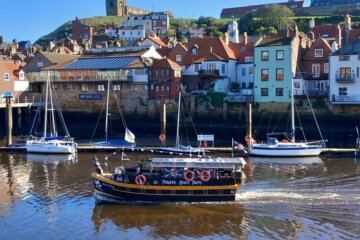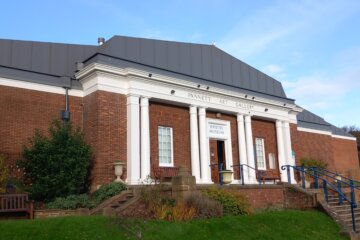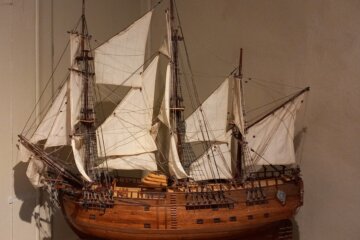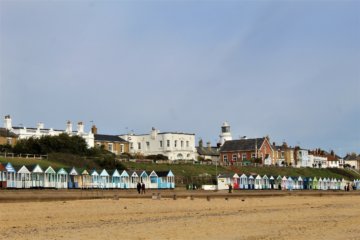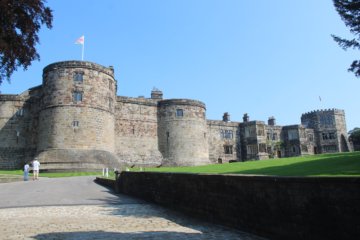Take the Aksaray – Havaaları (Atatürk Airport) tram line and alight at Topkapı-Ulubatlı. You will emerge from the tram station next to a section of the city’s ancient walls, which you should follow northwards. These walls were built by Theodosius II in 413AD. The choice is yours – you can either walk inside the walls, in which case you will be walking through a less than salubrious area of Istanbul which has been earmarked for redevelopment, but, which, at the time of writing is something of a half-demolished shanty town with grubby children and scrawny dogs running around, or you can walk outside the walls on the grass. Either way, you should walk uphill for about 15 minutes until you reach Edirnekapı, one of the gates in the Theodosian walls. You will know you’ve arrived by the number of minibuses congregated there.
To your right, you will see the Mihrimmah Sultan Mosque, commissioned by Süleyman the Magnificent’s favourite daughter, Mihrimah and built in the 1560s. At the time of writing, the mosque was closed for major restoration work, so I am unable to verify what I am about to say, but a student told me that the mosque is noted for its many stained glass windows and for the fact that it occupies the highest point in Istanbul.
From here, continue along the inside of the walls towards the Golden Horn. You will cross a busy road, Fevzi Paşa Caddesi, after which you should take the second road on the right, Kariye Bostanı Sokak, following signs pointing the way to the Kariye Müzesi (Chora Church). At the bottom of the hill, turn left and you will see the church, fronted by an attractive square filled with cafes and souvenir stands.
The entrance fee is 15TL, but is well worth paying, especially if you manage to time your visit so that it doesn’t coincide with one by several coach-loads of tourists from one of the cruise ships which will invariably be moored on the Bosphorus. The museum is open from 9am to 4.30pm every day except Wednesday.
There has been a church on this site since before the city walls were built, but the building you see now mainly dates from the 11th century and is not particularly remarkable, but, once you pass through the door and catch your first glimpse of the interior, you will be blown away by the beauty both of the famous mosaics and the lesser-known, but equally striking, frescoes. Virtually all of the interior decoration dates from 1312. The mosaics depict the lives of Jesus and his mother, Mary, and are absolutely stunning. The frescoes are thought to have been painted by the same masters who created the mosaics, although no-one knows for sure. Whoever was responsible, the paintings are indeed remarkable, with a sophisticated use of perspective and exquisitely drawn facial expressions to rival those painted by the Italian master, Giotto. For several hundred years, whilst the building was being used as a mosque, the mosaics and frescoes were covered with layers of plaster and whitewash. When these layers were carefully removed between 1948 and 1959, the paintings and mosaics underneath were surprisingly intact, giving us the spectacle which we can all enjoy today. Make sure you take the time to savour this amazing collection of art.
On leaving the Chora Church, it may be time to stop for a bite to eat. Choose between a snack at the Kariye Pembe Köşk, or splash out on a full-blown (but expensive) lunch at the Asitane restaurant next door. I haven’t sampled the food there, but my students tell me that it is amongst the best in Istanbul.
To continue your walk to the Golden Horn, take the first street on the left past the Kariye Oteli. This is Neşler Sokak. Turn left at the bottom of the hill and then continue along Fethiye Caddesi for around 30 minutes. This walk is largely uphill through an interesting shopping district with plenty of local character to keep your interest. At the top of the hill, the road bends around to the right and becomes Marıyasizade Caddesi. Follow this, past more unusual little shops, for about 10 minutes until you come to a police station where you should turn left on to Sultan Selim Caddesi.
You will pass the huge, open Roman Cistern of Aspar on your left, built in about 420AD and now used as a sports ground. Just beyond this, is the Sultan Selim Mosque, well-used as a place of worship by locals, but with little of interest to tourists. Its best feature is the fantastic view down to the Golden Horn which you get from the lawn in front of the mosque. You do, however, get an equally good view from the road which skirts the outer perimeter of the mosque’s grounds.
From here, having taken in the panorama, giving precise instructions as to which road to take becomes a little difficult as there are many narrow, cobbled streets with closely built houses on either side. What you need to do is keep going in roughly a straight line downwards! You are aiming to reach the water of the Golden Horn. The streets are very steep in parts, so make sure that you’re wearing sensible footwear!
If all goes according to plan, you should reach level ground and be in sight of the water to your left. At this point, it is up to you, but I suggest a short walk further up the Golden Horn to the Church of St. Stephen of the Bulgars. This is well worth a visit, and is described in a separate posting. Alternatively, if you time it correctly (5 minutes past the hour), you could get on the ferry at Fener (very close to where you are), cross to Hasköy on the opposite shore of the Golden Horn, and visit the superb Rahmi M Koç Museum, which is also described in a separate posting – http://worldteacher-andrea.blogspot.com/2009/05/rahmi-m-koc-museum.html.
Whichever you choose, I hope you enjoy your day in this less famous district of Istanbul. Please feel free to add your comments!
Join our mailing list

Sign up to receive our monthly newsletter. Keep up with what we're doing and be the first to receive special offers and insider tips.



